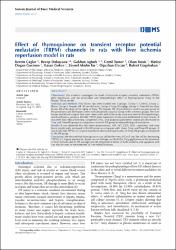Effect of thymoquinone on transient receptor potential melastatin (TRPM) channels in rats with liver ischemia reperfusion model in rats

Access
info:eu-repo/semantics/closedAccessDate
2024Author
Çaglar, KeremDokuyucu, Recep
Ağtürk, Gökhan
Tümer, Cemil
Tutuk, Okan
Göçmen, Hatice Doğan
Gökçe, Hasan
Taş, Zeynel Abidin
Özcan, Oğuzhan
Göğebakan, Bülent
Metadata
Show full item recordCitation
Çağlar, K., Dokuyucu, R., Ağtürk, G., Tümer, C., Tutuk, O., Göçmen, H. D., Gökçe, H., Taş, Z. A., Özcan, O., & Göğebakan, B. (2024). Effect of thymoquinone on transient receptor potential melastatin (TRPM) channels in rats with liver ischemia reperfusion model in rats. Journal Information IRANIAN JOURNAL OF BASIC MEDICAL SCIENCES, 27(3), 319-325. https://doi.org/10.22038/IJBMS.2023.71990.15647Abstract
Objective(s): We aimed to investigate the levels of transient receptor potential melastatin (TRPM)
gene expression, and the antioxidant and histopathologic effect of thymoquinone (Tmq) in the
hepatic I/R rat model.
Materials and Methods: Fifty Wistar rats were divided into 5 groups. Group 1: Control; Group 2:
Sham; Group 3: Hepatic I/R (45 min/45 min); Group 4: Tmq (50 mg/kg); Group 5: Tmq+I/R (ten days
before I/R at the dose of 50 mg/kg of Tmq). The hepatic I/R (45min/45min) model was performed at
the portal vein and the hepatic artery with atraumatic vascular clamp in the ischemia groups. The liver
tissues and blood samples that were taken at the end of the study were evaluated for histopathologic
and biochemical analysis. Besides TRPM gene expression levels were determined in liver tissues. It
was seen that cellular swelling, congestion, PNL, and apoptosis parameters statistically decreased in
Tmq and Tmq+I/R groups in comparison with the I/R group in histopathological evaluation.
Results: It was observed that biochemical parameters, AST, ALT, GGT, LDH, creatinine, and urea
levels significantly increased in the I/R group as compared with, sham, Tmq, and Tmq+I/R groups. It
was found that TRPM2,6,7,8 gene expression decreased significantly in Tmq+I/R groups as compared
to the I/R group.
Conclusion: We showed that thymoquinone can inhibit the entry of Ca+2 into the cell by decreasing
TRPM2,6,7,8 gene expression. Based on our findings, we think that Tmq application in the treatment
of liver diseases due to I/R damage may be important in terms of both ischemia and apoptosis and
can also be used in the treatment of liver-related diseases.
















